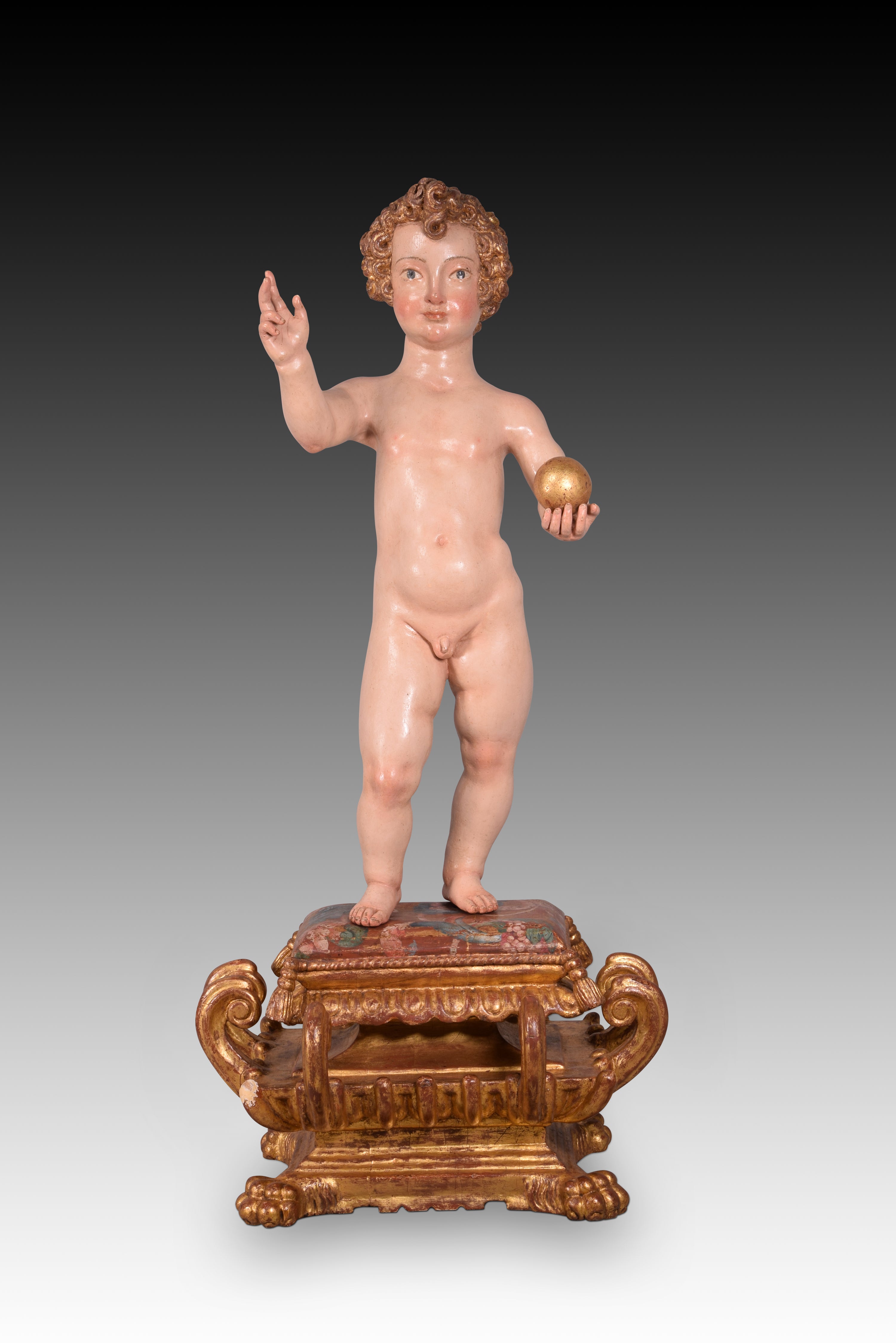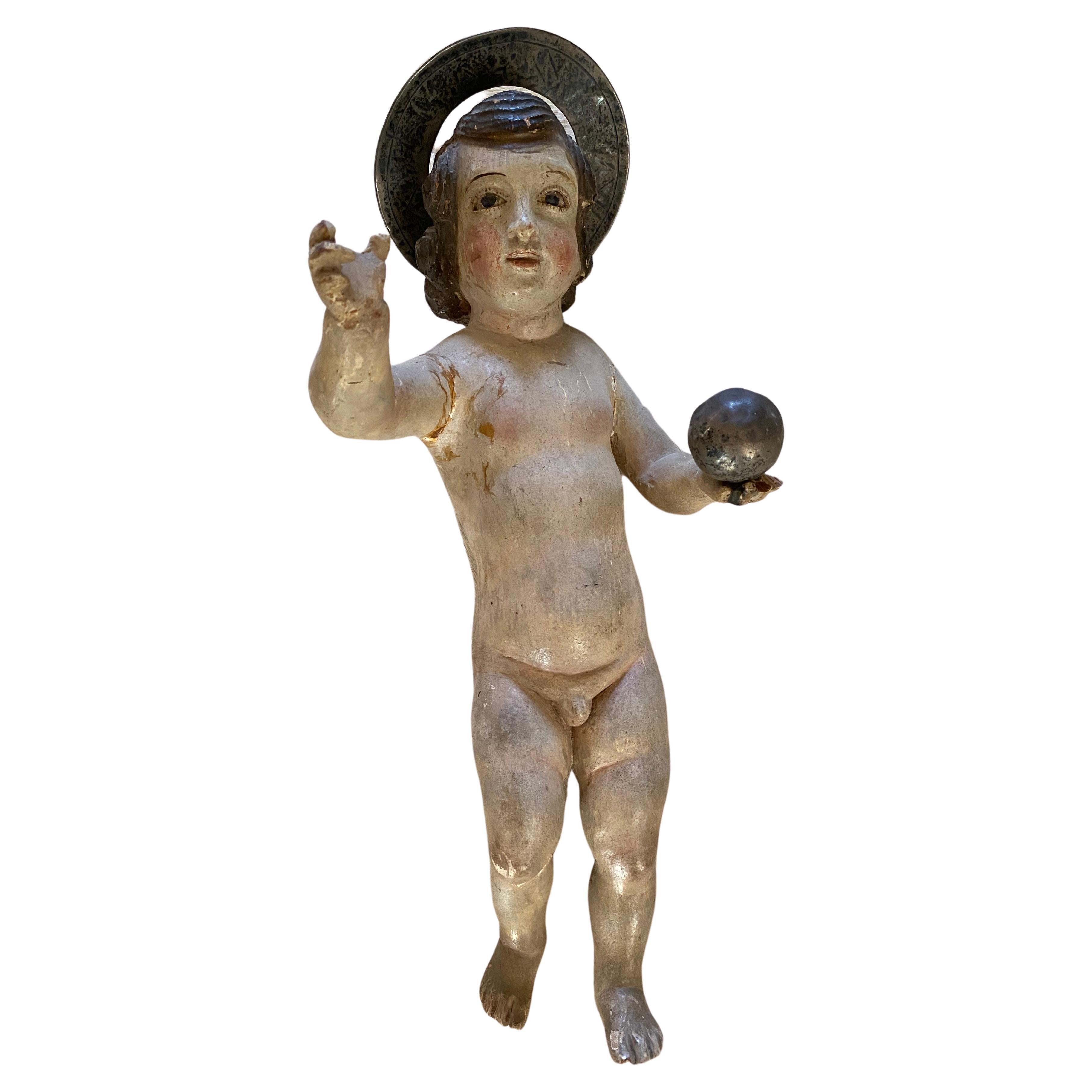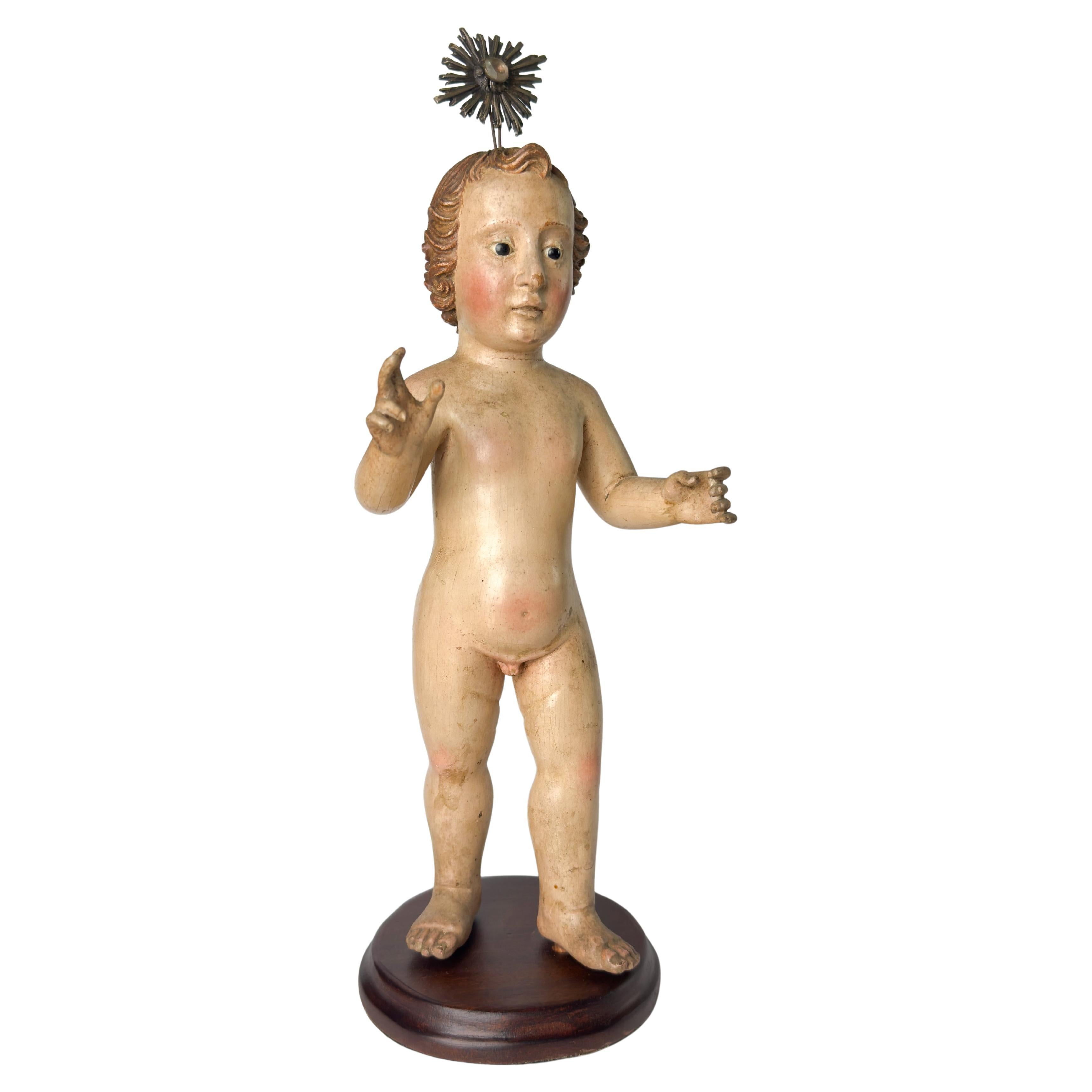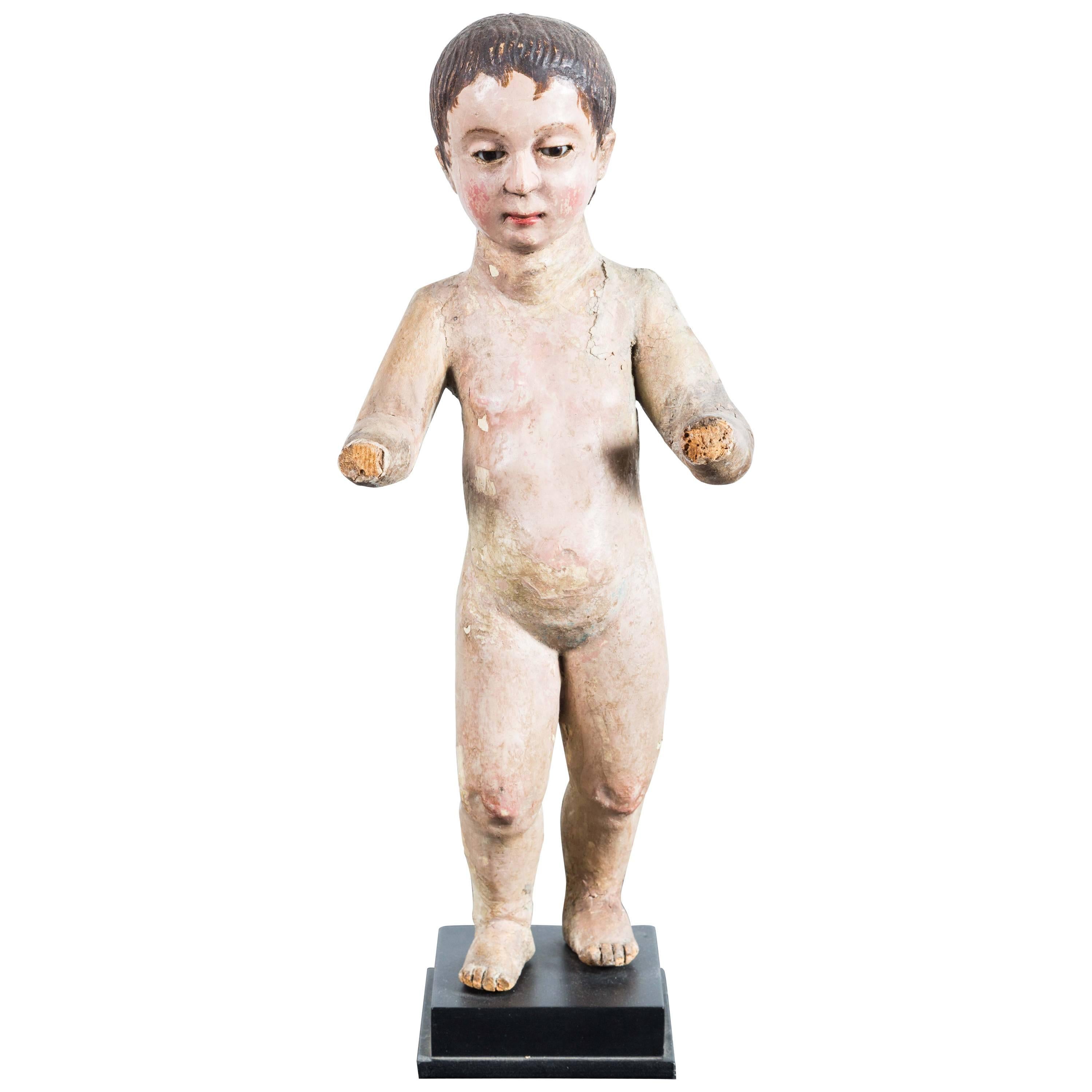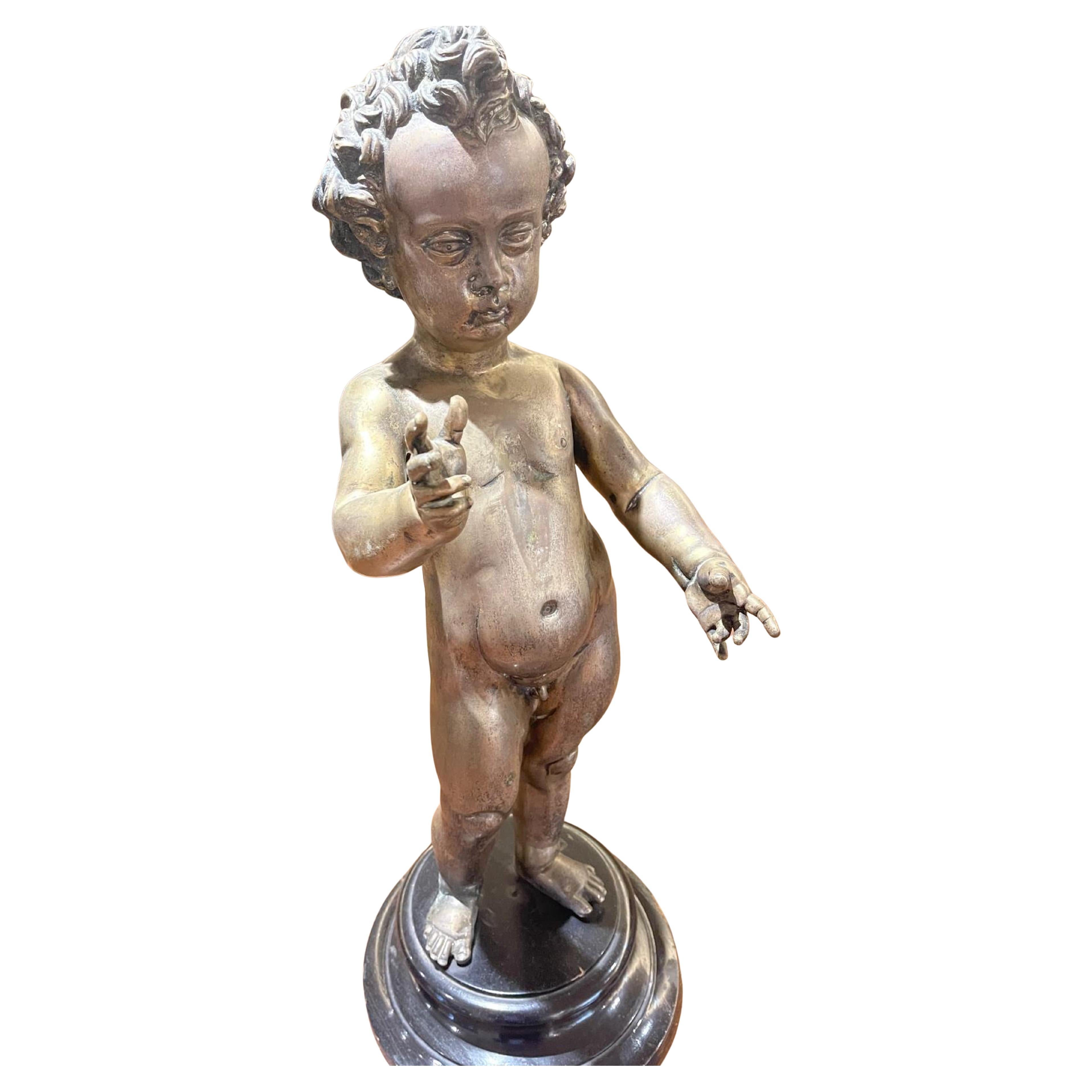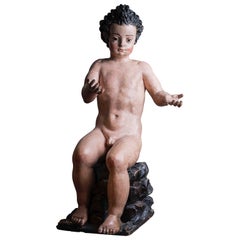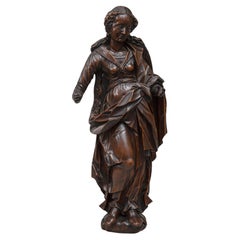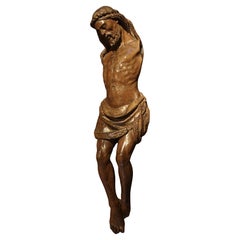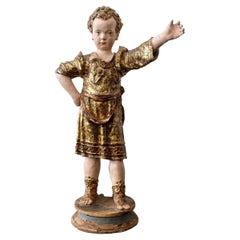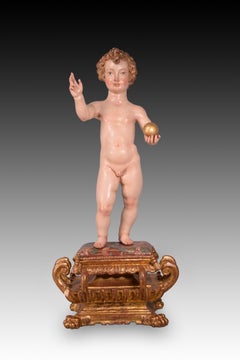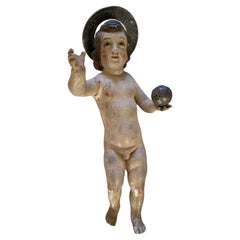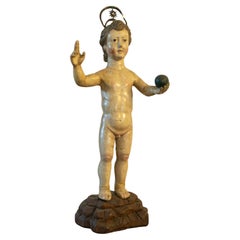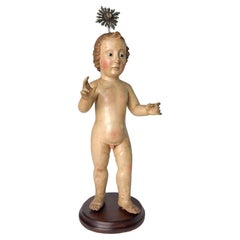Items Similar to Child Jesus - Umbria, first half of the 16th century
Want more images or videos?
Request additional images or videos from the seller
1 of 5
Child Jesus - Umbria, first half of the 16th century
$4,551.41
£3,372.85
€3,800
CA$6,213.54
A$6,912.31
CHF 3,623.52
MX$84,466.74
NOK 46,141
SEK 43,435.37
DKK 28,932.87
Shipping
Retrieving quote...The 1stDibs Promise:
Authenticity Guarantee,
Money-Back Guarantee,
24-Hour Cancellation
About the Item
Child Jesus
Polychrome and gilded wood
Umbria, first half of the 16th century
H 40 cm
Entirely naked, the Child is standing, leaning on his left leg, his right leg forward; he keeps his gaze fixed on the front, while raising one arm in an attitude of blessing; full-cheeked face with high forehead; beautiful curly golden hair; prominent belly and thighs marked by rolls.
- Dimensions:Height: 15.75 in (40 cm)Diameter: 7.09 in (18 cm)
- Style:Renaissance (Of the Period)
- Materials and Techniques:
- Place of Origin:
- Period:
- Date of Manufacture:16th century
- Condition:Wear consistent with age and use.
- Seller Location:Bruxelles, BE
- Reference Number:1stDibs: LU6666240726932
About the Seller
5.0
Vetted Professional Seller
Every seller passes strict standards for authenticity and reliability
1stDibs seller since 2022
15 sales on 1stDibs
Typical response time: 4 hours
- ShippingRetrieving quote...Shipping from: Bruxelles, Belgium
- Return Policy
Authenticity Guarantee
In the unlikely event there’s an issue with an item’s authenticity, contact us within 1 year for a full refund. DetailsMoney-Back Guarantee
If your item is not as described, is damaged in transit, or does not arrive, contact us within 7 days for a full refund. Details24-Hour Cancellation
You have a 24-hour grace period in which to reconsider your purchase, with no questions asked.Vetted Professional Sellers
Our world-class sellers must adhere to strict standards for service and quality, maintaining the integrity of our listings.Price-Match Guarantee
If you find that a seller listed the same item for a lower price elsewhere, we’ll match it.Trusted Global Delivery
Our best-in-class carrier network provides specialized shipping options worldwide, including custom delivery.More From This Seller
View AllCercle of Juan Martinez Montañés '1568-1649', Infant St John the Baptist
Located in Bruxelles, BE
Cercle of Juan Martinez Montañés (1568-1649)
Infant St John the Baptist
Spanish, 17th century
H 74 cm
Saint John the Baptist is here represented naked, sitting on a rock, with...
Category
Antique 17th Century Spanish Renaissance Figurative Sculptures
Materials
Wood
Statuette of the Virgin, South German circa 1600
Located in Bruxelles, BE
Statuette of the Virgin
South-German, circa 1600
sculpted wood
circa 1600
(right arm restored)
52 cm
Category
Antique 17th Century German Renaissance Religious Items
Materials
Wood
Christ - Umbria, second half of the 15th century
Located in Bruxelles, BE
Christ
Umbria, Orvieto?
Second half of the 15th century
77 x 16.5 cm
Category
Antique 15th Century and Earlier Italian Renaissance Figurative Sculptures
Materials
Walnut
Cercle of Romano Alberti, Page, Around 1530-1540
Located in Bruxelles, BE
Cercle of Romano Alberti, dit Il Nero da Sansepolcro ( San Sepolcro, 1521-1568 )
Page
Mixed media : wood core, papier mâché, stucco, polychrome and gilded
Italy, around 1530-154...
Category
Antique 16th Century Italian Renaissance Figurative Sculptures
Materials
Stucco, Wood, Paper
$12,456 Sale Price
35% Off
Carlo Marcellini 'Florence 1644 – 1713', Florentine Baroque Putto
Located in Bruxelles, BE
Carlo Marcellini (Florence 1644 – 1713)
Putto
White and green marble
41.5 x 73.5 cm
This marble putto carved in high relief, almost a tutto tondo, and set on an elegant green marble background, appears almost naked, sitting on a cloud. His peculiar pose, in adoration, suggests that the work was a part of a larger composition including other figures in devotion.
Published in 2007 by Sandro Bellesi in the monograph dedicated to Gioacchino Fortini (pg.155), this beautiful marble putto was included in the catalog of Carlo Marcellini, a prominent figure in the baroque renewal of Florentine art.
Born in Florence in 1644, Carlo Marcellini received his artistic education in the city of the lily, specializing in stone sculpture and stucco modeling under the guidance of Bartolomeo Cennini before continuing his studies in Rome in the Accademia Medicea founded by the Grand Duke Cosimo III in order to familiarize some more promising artists with the essential “ taste of Rome ”.
Under the guidance of Ercole Ferrata and Ciro Ferri, Giovan Battista Foggini...
Category
Antique 17th Century Italian Baroque Figurative Sculptures
Materials
Marble
Saint John the Baptist
- After a model by Bertoldo di Giovanni
Located in Bruxelles, BE
Saint John the Baptist
Bronze
After a model by Bertoldo di Giovanni (ca. 1440–1491)
Northern Italy, 18th century
27,5 x 8 x 5 cm
This finely cast and patinated bronze statuette ...
Category
Antique Late 18th Century Italian Renaissance Figurative Sculptures
Materials
Bronze
You May Also Like
"Child Jesus", Wood, Spanish School, 17th Century, pedestal made later.
Located in Madrid, ES
"Child Jesus". Carved and polychrome wood. Spanish school, 17th century. Base or pedestal made later.
Christ is presented naked, with a slight contrapposto on the legs and hips that...
Category
Antique 17th Century Spanish Baroque Religious Items
Materials
Other
18th Century Italian Carved Wood and Polychromed Figure of Baby Jesus
Located in Ballard, CA
18th century exceptional Italian carved wood and polychromed figure depicting baby Jesus holding the world in his hand, he has halo made from sterling silver and the globe is also sterling silver.This piece would have originally been dressed in an elaborate gown and would have been changed into different attire depending on the holy season. Extremely detailed and the carving is exceptional. this piece came from a very reputable merchant in Verona, I did inherit it from my mother in Law...
Category
Antique Mid-18th Century Italian Baroque Figurative Sculptures
Materials
Silver
Jesus Salvator Mundi Sculpture, Flemish Religious Art, 17th Century
Located in Lisbon, PT
This masterfully carved 17th-century Flemish sculpture presents Jesus Christ as the “Salvator Mundi” — Savior of the World — a powerful icon of devotion and divine kingship.
Sculpte...
Category
Antique Late 17th Century Belgian Renaissance Figurative Sculptures
Materials
Wood, Chestnut
$5,453 Sale Price
20% Off
Jesus Of Mechelen Flemish Religious Sculpture, 17th Century
Located in Lisbon, PT
This 17th-century Flemish Baroque sculpture from Mechelen represents the Infant Jesus, arms outstretched in divine grace, blessing the viewer with serene charm.
A remarkable piece o...
Category
Antique Late 17th Century Belgian Baroque Figurative Sculptures
Materials
Wood
$5,453 Sale Price
20% Off
Late 19th Century Carved Spanish Colonial Christ Nino Santo with Glass Eyes
Located in Santa Monica, CA
Late 19th century carved baby Jesus Santos with glass eyes and custom display stand. Handmade with carved wood and gesso. Glass inset eyes. Left and r...
Category
Antique 19th Century South American Spanish Colonial Religious Items
Materials
Gesso, Wood
Important German Sculpture "CHILD JESUS" 17th Century
By Europa
Located in Madrid, ES
Important German Sculpture "CHILD JESUS" 17th Century
in silver metal.
Sitting on a wooden base.
Height (sculpture) 52 cm.
Height: (total) 60 cm
good original conditions
Category
Antique 17th Century German Baroque Figurative Sculptures
Materials
Metal
More Ways To Browse
Gilded Items
16th Century Italian Furniture
16th Century Italian Wood
Polychrome Jesus
Antique Nativities
Hand Carved Wood Crucifix
Antique Catholic Religious Items
Gothic Plaque
Silver Crucifix
Gold Menorah
Prayer Kneeler Antique
Antique Rosaries
Antique Rosary Rosaries
Dutch Gothic
Large Crucifix
Large Menorah
Religious Relics
Antique Holy Bible
